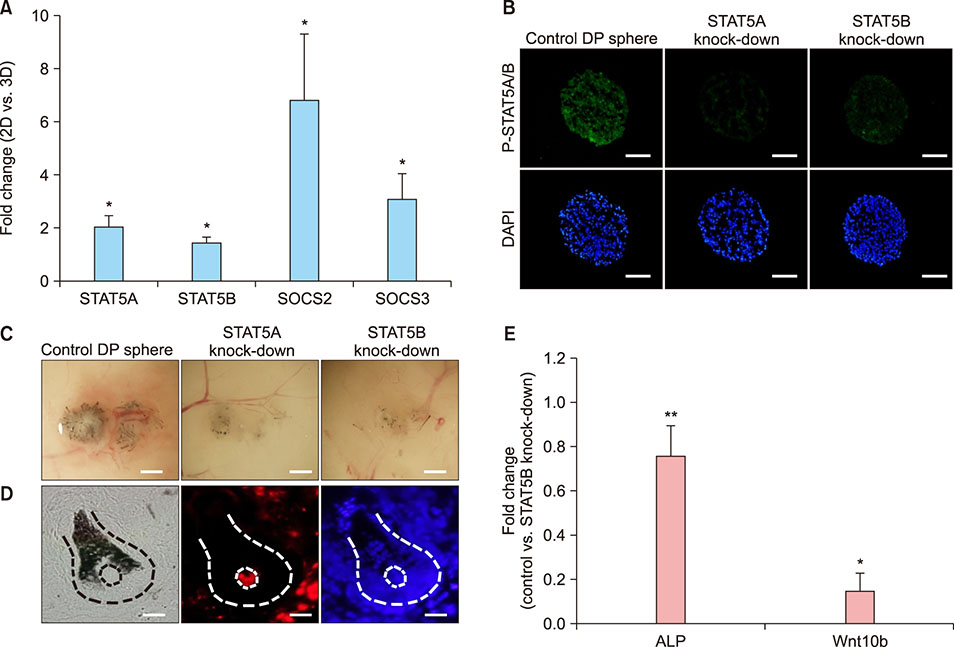Ann Dermatol.
2019 Apr;31(2):228-231. 10.5021/ad.2019.31.2.228.
Impairment of Hair-Inducing Capacity of Three-Dimensionally Cultured Human Dermal Papilla Cells by the Ablation of STAT5
- Affiliations
-
- 1New Drug Development Center, Daegu-Gyeongbuk Medical Innovation Foundation, Daegu, Korea.
- 2Department of Immunology, School of Medicine, Kyungpook National University, Daegu, Korea. ysung@knu.ac.kr
- KMID: 2439074
- DOI: http://doi.org/10.5021/ad.2019.31.2.228
Abstract
- No abstract available.
MeSH Terms
Figure
Reference
-
1. Ohyama M, Zheng Y, Paus R, Stenn KS. The mesenchymal component of hair follicle neogenesis: background, methods and molecular characterization. Exp Dermatol. 2010; 19:89–99.
Article2. Yang CC, Cotsarelis G. Review of hair follicle dermal cells. J Dermatol Sci. 2010; 57:2–11.
Article3. Ohyama M, Veraitch O. Strategies to enhance epithelialmesenchymal interactions for human hair follicle bioengineering. J Dermatol Sci. 2013; 70:78–87.
Article4. Kang BM, Kwack MH, Kim MK, Kim JC, Sung YK. Sphere formation increases the ability of cultured human dermal papilla cells to induce hair follicles from mouse epidermal cells in a reconstitution assay. J Invest Dermatol. 2012; 132:237–239.
Article5. Higgins CA, Chen JC, Cerise JE, Jahoda CA, Christiano AM. Microenvironmental reprogramming by three-dimensional culture enables dermal papilla cells to induce de novo human hair-follicle growth. Proc Natl Acad Sci U S A. 2013; 110:19679–19688.
Article6. Seo CH, Kwack MH, Lee SH, Kim MK, Kim JC, Sung YK. Poor capability of 3D-cultured adipose-derived stem cells to induce hair follicles in contrast to 3D-cultured dermal papilla cells. Ann Dermatol. 2016; 28:662–665.
Article7. Legrand JMD, Roy E, Ellis JJ, Francois M, Brooks AJ, Khosrotehrani K. STAT5 activation in the dermal papilla is important for hair follicle growth phase induction. J Invest Dermatol. 2016; 136:1781–1791.
Article8. Harel S, Higgins CA, Cerise JE, Dai Z, Chen JC, Clynes R, et al. Pharmacologic inhibition of JAK-STAT signaling promotes hair growth. Sci Adv. 2015; 1:e1500973.
Article9. Zheng Y, Du X, Wang W, Boucher M, Parimoo S, Stenn K. Organogenesis from dissociated cells: generation of mature cycling hair follicles from skin-derived cells. J Invest Dermatol. 2005; 124:867–876.
Article10. McElwee KJ, Kissling S, Wenzel E, Huth A, Hoffmann R. Cultured peribulbar dermal sheath cells can induce hair follicle development and contribute to the dermal sheath and dermal papilla. J Invest Dermatol. 2003; 121:1267–1275.
Article
- Full Text Links
- Actions
-
Cited
- CITED
-
- Close
- Share
- Similar articles
-
- Effects of Alopecia Areata Serum on Proliferation of Cultured Dermal Papilla Cells
- Effects of Vaseular Endothelial Growth Factors on Hair Growth in Vitro
- Effects of Substance P on the Expression of Various Factors to control Hair Growth in Human Hair Follicle Culture
- The Effect of Medications Used in Mesotherapy on Hair Organ Culture and Culture of Dermal Papilla Cells
- Effects of Calcitonin Gene-Related Peptide on the Hair Growth in Human Hair Follicle Organ Culture


